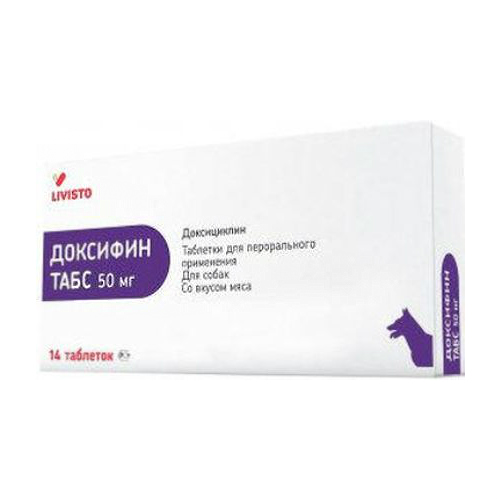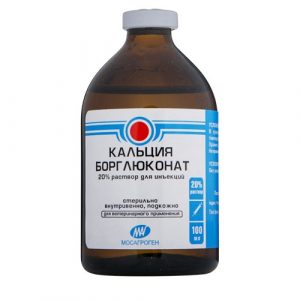Description
Pharmacological action
Doxyphin, which has a bacteriostatic effect, is prescribed for the treatment of cats and dogs for various diseases caused by pathogens sensitive to doxycycline: Ehrlichia canis, Bordetella bronchiseptica, Pasteurella multocida type A, Arcanobactericium colinea ehrlichiosis, respiratory tract infections, gastrointestinal tract, genitourinary system and infections of the skin. Effective treatment. Once-daily intake. Ease of use, meat-flavored tablets. Broad spectrum of action. Divisible tablets per 5 kg. Weight. DoxifinВ® Tabs is an antibiotic based on doxycycline for oral administration. Doxycycline belongs to the class of tetracyclines that effectively fight a wide range of bacteria, especially with intracellular organisms. Due to the high level of fat solubility, it reaches a higher intracellular concentration compared to other tetracyclines.
Dosage and administration
Doxifin tablets must be given to the animal in accordance with the recommended dose for a specific weight, from the owner’s hands, without mixing with other food or additives, there is no need to pre-plant the animal on a diet or change diet. Dosage: The therapeutic dosage of doxycycline is 10 mg / kg live weight, used once a day for 7 consecutive days, or in the treatment of ehrlichiosis for 28 consecutive days, or at the discretion of a veterinarian.
Side effects
The results of a clinical study confirmed the safety of the product at the indicated dosage once a day for 30 days for dogs and cats older than 1 year. The safety of the drug was not evaluated in elderly animals and animals during the mating season. Tetracyclines form chelating compounds with calcium phosphorus in the teeth and bones, penetrate structures, delay calcification, and can lead to hypoplasia of tooth enamel, staining it yellow, and then brown. Despite the lower level of the chelating compound with doxycycline, it is not recommended to use the drug in animals during the period of development and growth of teeth. According to research reports, the most common side effects are nausea, vomiting, hypersensitivity, and small drug photosensitivity. In cats, narrowing of the esophagus, fever, and depression were revealed.
Drug Interactions
Iron, aluminum, calcium, zinc, manganese reduce the concentration in the blood serum and the bioavailability of tetracyclines as a result of their ability to form chelate compounds with metal ions. Doxycycline has a rather low affinity for calcium ions, however, it is recommended to take a 1-2-hour break before or after the introduction of tetracycline with these drugs. Tetracyclines may decrease plasma prothrombin activity, and dosage adjustment may be required for animals undergoing anticoagulant treatment. Concomitant administration of tetracycline with theophylline can worsen side effects on the digestive tract. The presence of H2 antihistamines may decrease the absorption of tetracyclines. Tetracyclines should not be used in conjunction with penicillin and cephalosporin in connection with the weakening bactericidal action of penicillins. Antacids can reduce the bioavailability of doxycycline by 85%. In this case, the interval between the introduction of these drugs should be 2 hours or more. Inductors of microsomal oxidation enzymes, such as phenobarbital and phenytoin, reduce the concentration of doxycycline in plasma. Complex B vitamins, iron preparations, antacids and kaolin reduce the activity of tetracyclines.
active substance
Doxycycline
dosage form
tablets



